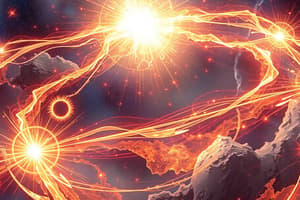Podcast
Questions and Answers
The Strong Nuclear Force holds atomic nuclei together and is the strongest force over long distances.
The Strong Nuclear Force holds atomic nuclei together and is the strongest force over long distances.
False (B)
According to Newton's Second Law, force is equal to mass times acceleration, represented as F = ma.
According to Newton's Second Law, force is equal to mass times acceleration, represented as F = ma.
True (A)
Kinetic Energy is calculated using the formula $KE = mv^2$.
Kinetic Energy is calculated using the formula $KE = mv^2$.
False (B)
The Second Law of Thermodynamics states that entropy in an isolated system can decrease over time.
The Second Law of Thermodynamics states that entropy in an isolated system can decrease over time.
Electromagnetic Induction involves the creation of electric current through changing magnetic fields.
Electromagnetic Induction involves the creation of electric current through changing magnetic fields.
A transverse wave has displacement parallel to the wave direction.
A transverse wave has displacement parallel to the wave direction.
The First Law of Thermodynamics states that energy cannot be created or destroyed, only transformed.
The First Law of Thermodynamics states that energy cannot be created or destroyed, only transformed.
General Relativity describes gravity as a force exerted by masses in space.
General Relativity describes gravity as a force exerted by masses in space.
Flashcards are hidden until you start studying
Study Notes
Key Concepts in Physics
Fundamental Forces
- Gravitational Force: Attraction between masses; weakest force.
- Electromagnetic Force: Interaction between charged particles; responsible for electricity and magnetism.
- Weak Nuclear Force: Responsible for radioactive decay.
- Strong Nuclear Force: Holds atomic nuclei together; strongest force over short distances.
Laws of Motion
- Newton's First Law: An object in motion stays in motion unless acted upon by a net external force (inertia).
- Newton's Second Law: Force equals mass times acceleration (F = ma).
- Newton's Third Law: For every action, there is an equal and opposite reaction.
Energy
- Kinetic Energy: Energy of motion; ( KE = \frac{1}{2}mv^2 ).
- Potential Energy: Stored energy due to position; gravitational potential energy ( PE = mgh ).
- Conservation of Energy: Energy cannot be created or destroyed, only transformed.
Thermodynamics
- First Law: Energy conservation; the change in internal energy equals heat added minus work done.
- Second Law: Entropy of an isolated system always increases; heat cannot spontaneously flow from cold to hot.
- Third Law: As temperature approaches absolute zero, the entropy of a perfect crystal approaches zero.
Waves and Oscillations
- Wave Properties: Wavelength, frequency, amplitude, speed.
- Types of Waves:
- Transverse: Displacement perpendicular to wave direction (e.g., light).
- Longitudinal: Displacement parallel to wave direction (e.g., sound).
- Reflection, Refraction, and Diffraction: Fundamental behaviors of waves when encountering obstacles or media changes.
Electricity and Magnetism
- Ohm's Law: Voltage = Current x Resistance (V = IR).
- Magnetic Fields: Created by moving charges; affects charged particles.
- Electromagnetic Induction: Changing magnetic fields can induce an electric current (Faraday's Law).
Modern Physics
- Quantum Mechanics: Describes the behavior of particles at atomic scales; key principles include wave-particle duality and the uncertainty principle.
- Relativity:
- Special Relativity: Laws of physics are the same in all inertial frames, light speed is constant.
- General Relativity: Gravity is a curvature of spacetime caused by mass.
Problem-Solving Techniques
- Dimensional Analysis: Checking the consistency of equations by comparing units.
- Free Body Diagrams: Visual representation of forces acting on an object.
- Energy Methods: Use conservation principles to solve problems involving motion and forces.
Important Units
- Force: Newton (N)
- Energy: Joule (J)
- Power: Watt (W)
- Charge: Coulomb (C)
- Pressure: Pascal (Pa)
Fundamental Forces
- Gravitational force results from the attraction between masses; it is the weakest of all fundamental forces.
- The electromagnetic force governs interactions between charged particles, being responsible for both electricity and magnetism.
- The weak nuclear force is crucial in processes like radioactive decay.
- The strong nuclear force is the most powerful force over short distances, essential for holding atomic nuclei together.
Laws of Motion
- Newton's First Law states that an object will remain at rest or continue in uniform motion unless acted upon by an external force, illustrating the concept of inertia.
- Newton's Second Law establishes the relationship between force, mass, and acceleration, summarized by the formula ( F = ma ).
- Newton's Third Law introduces the principle that for every action, there is an equal and opposite reaction.
Energy
- Kinetic energy is the energy of motion, expressed mathematically as ( KE = \frac{1}{2}mv^2 ).
- Potential energy reflects stored energy related to an object's position, with gravitational potential energy calculated by ( PE = mgh ).
- The principle of conservation of energy asserts that energy cannot be created or destroyed but can only undergo transformations.
Thermodynamics
- The First Law of Thermodynamics relates to energy conservation, stating that the change in internal energy equals the heat added to the system minus the work done by the system.
- The Second Law highlights that the entropy of an isolated system tends to increase over time, and heat transfer cannot spontaneously occur from colder to hotter regions.
- The Third Law posits that as temperature approaches absolute zero, the entropy of a perfect crystal approaches zero.
Waves and Oscillations
- Essential properties of waves include wavelength, frequency, amplitude, and speed.
- Transverse waves have particle displacement occurring perpendicular to wave propagation (e.g., light), while longitudinal waves feature particle displacement parallel to wave movement (e.g., sound).
- Reflection, refraction, and diffraction are fundamental wave behaviors as they interact with obstacles or change medium.
Electricity and Magnetism
- Ohm's Law defines the relationship between voltage, current, and resistance, expressed as ( V = IR ).
- Magnetic fields arise from moving charges and can influence the behavior of charged particles.
- Electromagnetic induction, as described by Faraday's Law, involves the generation of an electric current through varying magnetic fields.
Modern Physics
- Quantum mechanics describes particle behavior at atomic scales, emphasizing wave-particle duality and the uncertainty principle.
- Special relativity asserts that the laws of physics remain constant in all inertial frames of reference, with the speed of light as a universal constant.
- General relativity theorizes that gravity results from the curvature of spacetime influenced by mass.
Problem-Solving Techniques
- Dimensional analysis ensures the validity of equations by validating the consistency of units.
- Free body diagrams serve as visual tools to depict the various forces acting upon an object.
- Energy methods involve applying conservation principles to analytically solve motion and force problems.
Important Units
- Force is measured in Newtons (N).
- Energy is quantified in Joules (J).
- Power is expressed in Watts (W).
- Electric charge is represented in Coulombs (C).
- Pressure is measured in Pascals (Pa).
Studying That Suits You
Use AI to generate personalized quizzes and flashcards to suit your learning preferences.




